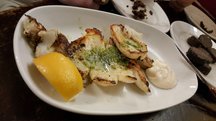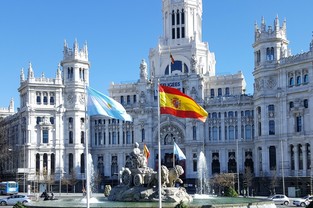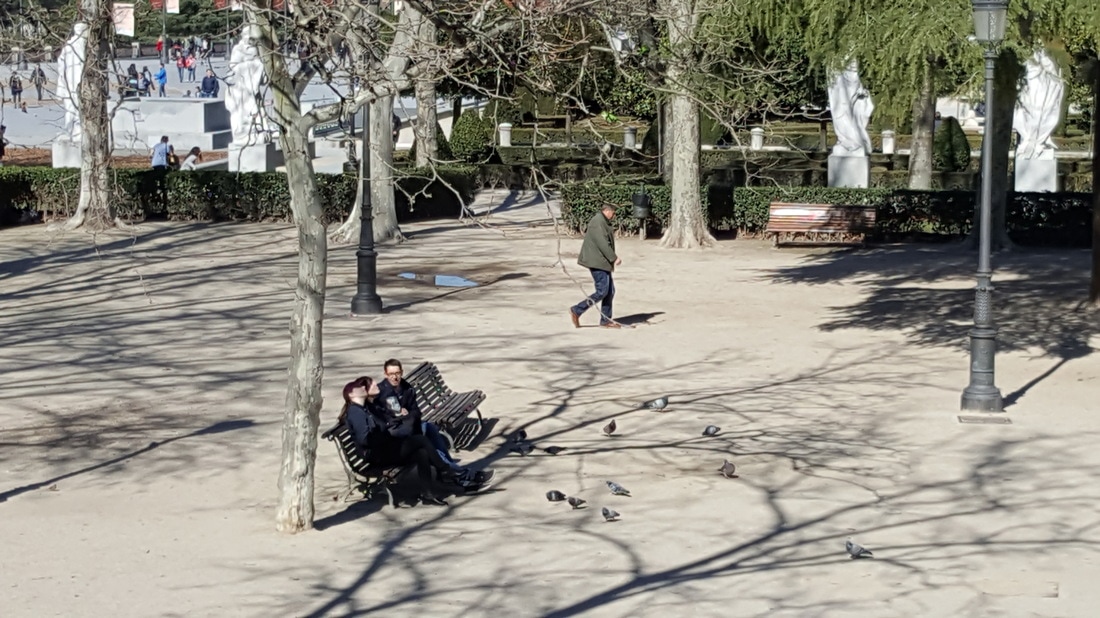
When Mark and I landed in Madrid, we quickly went through customs and asked for directions to our hotel. The people in the airport were very friendly and told us to take the bus to the Atocha stop, about 35 minutes away. The bus was an express, only $5 and left the station often. Atocha is the largest railway station in Madrid (and Spain). It is the primary station serving commuter trains, intercity and regional trains from the south, and the AVE high speed trains from Barcelona, Seville and Valencia. You can go from Madrid to Valencia in just 1 hour and 35 minutes. There is also a high speed train from Barcelona to Madrid. Prices vary on the demand and times. They range from $50 to $150.
When we got off the bus, we were entranced with the dance of people in the streets, the buildings, and the hustle and bustle of cars. Our hotel was only a block away, so we walked to Hotel Paseo del Arte.
We were situated right in the middle of the art district. The hop off and on bus was around the corner, subway across the street, and easy access to many museums.
When we got off the bus, we were entranced with the dance of people in the streets, the buildings, and the hustle and bustle of cars. Our hotel was only a block away, so we walked to Hotel Paseo del Arte.
We were situated right in the middle of the art district. The hop off and on bus was around the corner, subway across the street, and easy access to many museums.
Museums
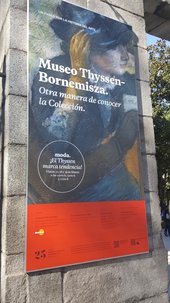
.We were so excited to see the sites, we decided to drop our bags and go sightseeing right away.
We were only about 5 blocks from the Golden Art Triangle: The Prado, Queen Sofia, and Thyssen-Bornemisza Museums. However, we thought we'd start with a quick hop off and on tour of the city. We bought a 2 day pass which was a bargain. After a quick circle, we went back to the Prado and toured the museum. The Prado has 8600 paintings. Many of them are religious in nature. They range from Italian, Flemish, German, and Spanish. The Thyssen-Bornemisza Museum is right across the street. It opened in 1992 and has 14th and 15th Century paintings as well as impressionistic and post impressionistic paintings, even some from the 20th Century. If you like the mix of modern and realistic, I recommend the Thyssen Museum. You can get in free on Mondays. The Queen Sofia Museum is not far either. It is a Spanish museum with contemporary art. It is closed on Tuesday.
We were only about 5 blocks from the Golden Art Triangle: The Prado, Queen Sofia, and Thyssen-Bornemisza Museums. However, we thought we'd start with a quick hop off and on tour of the city. We bought a 2 day pass which was a bargain. After a quick circle, we went back to the Prado and toured the museum. The Prado has 8600 paintings. Many of them are religious in nature. They range from Italian, Flemish, German, and Spanish. The Thyssen-Bornemisza Museum is right across the street. It opened in 1992 and has 14th and 15th Century paintings as well as impressionistic and post impressionistic paintings, even some from the 20th Century. If you like the mix of modern and realistic, I recommend the Thyssen Museum. You can get in free on Mondays. The Queen Sofia Museum is not far either. It is a Spanish museum with contemporary art. It is closed on Tuesday.
City Center

After all our sightseeing, we went back to the hotel and took a short rest. At 6:00 pm we met our foreign exchange student's mother, Elsa. It was such a treat to be with her. She took us to the center of the city. The center is a very robust area with lots of shops and restaurants. The first place we went was Plaza Mayor Square. It is a large square where there are markets, cafes, even soccer games and bullfights at times. There were a lot of people in the square with singers and people dancing. There were also people dressed up like cartoon characters and space aliens. It reminded me of Times Square in New York except without the cowboy.
There are several shops and one of the main ones is El Cortes Ingles. We went to the top floor, 9th. The view was awesome. We were there at dusk ans saw the sunset. They have dining inside and out. The top floor also has a gourmet section, with outstanding views.
The basement has a grocery. It is fun to shop and look at prices and Spanish food. After enjoying the sunset, we took a walk down several of the streets. We were in the midst of the Plaza del Callao. It is a busy square bustling with people. The buildings are art deco, especially the Callao Cinema Building and the Carrion Building with its neon Schweppes billboard. It was amazing to see all the lights. Again, New York's Time Square is a good comparison to the tall building around the center of the city. There were a variety of large and small stores. I even recognized a few names such as Taco Bell. However, some of the restaurants, were small and only sold food from a window. Their pork sandwiches are a specialty. We opted for a small, inside restaurant. Elsa made sure that we knew what traditional Spanish food was like. Here is our menu: Muddy Pies (small round shapes of dark brown rice), Boiled fish with eggs, and a plate of cold cuts (a variety of types of ham including jamon and salami) served with bread. I love their ham; I know that Squid and Calamari are also very popular. There is a fried calamari sandwich that is a signature dish. It is a lot of fun to try different foods. After dinner we took the subway back to our hotel. The subways are great and easy way to get around the city.
There are several shops and one of the main ones is El Cortes Ingles. We went to the top floor, 9th. The view was awesome. We were there at dusk ans saw the sunset. They have dining inside and out. The top floor also has a gourmet section, with outstanding views.
The basement has a grocery. It is fun to shop and look at prices and Spanish food. After enjoying the sunset, we took a walk down several of the streets. We were in the midst of the Plaza del Callao. It is a busy square bustling with people. The buildings are art deco, especially the Callao Cinema Building and the Carrion Building with its neon Schweppes billboard. It was amazing to see all the lights. Again, New York's Time Square is a good comparison to the tall building around the center of the city. There were a variety of large and small stores. I even recognized a few names such as Taco Bell. However, some of the restaurants, were small and only sold food from a window. Their pork sandwiches are a specialty. We opted for a small, inside restaurant. Elsa made sure that we knew what traditional Spanish food was like. Here is our menu: Muddy Pies (small round shapes of dark brown rice), Boiled fish with eggs, and a plate of cold cuts (a variety of types of ham including jamon and salami) served with bread. I love their ham; I know that Squid and Calamari are also very popular. There is a fried calamari sandwich that is a signature dish. It is a lot of fun to try different foods. After dinner we took the subway back to our hotel. The subways are great and easy way to get around the city.
Architecture and Fountains

Our hop on and off ride continued the next day. We had to visit some of the things that we couldn't see the day before.
Just looking at the architecture as we drove around the streets was amazing. So many buildings in Madrid look like palaces that you feel as if you are transported to a kingdom of different cultures and times. As you took the tour, you had a narrated story of the culture and historical significance of the buildings that were preserved by the Spaniards.
The squares also have fascinating statues and fountains. One of them is Cibeles Square and is found at the intersection of Alcala Street, the Paseo de Recoletos and the Paseo del Prado (south, towards the fountain of Neptune). This place is one of the most symbolic of the capital.
In the center of square, is situated the famous fountain of Cibeles, sculpted in 1782. It is a neo-classical complex of marble sculpture that has become an iconic symbol for the city of Madrid. The fountain of Cibeles has been adopted by the Football Club Real Madrid, whose fans use the area to celebrate its triumphs in competitions. Make a wish on the Cibeles fountain. It was made in homage of the goddess Cybele in the form of a beautifully ornate statue in her likeness on a chariot dragged by two lions. The fountain was built in the reign of Charles III between 1777 and 1782.
Appreciate the nearby Neptune Fountain which honors the god of the sea with his mighty trident and sea horses.
The streets are narrow, the city being very compact. One of the most famous streets is the Gran Via Ave. It is lined with many cinemas, theaters, night clubs, and bars.
Just looking at the architecture as we drove around the streets was amazing. So many buildings in Madrid look like palaces that you feel as if you are transported to a kingdom of different cultures and times. As you took the tour, you had a narrated story of the culture and historical significance of the buildings that were preserved by the Spaniards.
The squares also have fascinating statues and fountains. One of them is Cibeles Square and is found at the intersection of Alcala Street, the Paseo de Recoletos and the Paseo del Prado (south, towards the fountain of Neptune). This place is one of the most symbolic of the capital.
In the center of square, is situated the famous fountain of Cibeles, sculpted in 1782. It is a neo-classical complex of marble sculpture that has become an iconic symbol for the city of Madrid. The fountain of Cibeles has been adopted by the Football Club Real Madrid, whose fans use the area to celebrate its triumphs in competitions. Make a wish on the Cibeles fountain. It was made in homage of the goddess Cybele in the form of a beautifully ornate statue in her likeness on a chariot dragged by two lions. The fountain was built in the reign of Charles III between 1777 and 1782.
Appreciate the nearby Neptune Fountain which honors the god of the sea with his mighty trident and sea horses.
The streets are narrow, the city being very compact. One of the most famous streets is the Gran Via Ave. It is lined with many cinemas, theaters, night clubs, and bars.

Finally, we visited the Royal Palace of Madrid, which is the official residence of the royal family but is used only for ceremonies and state functions. Its beauty and grandeur surpasses that of any other castle in Europe, and was vaulted in stone and brick during its construction, rendering it indestructible over the centuries. The palace itself contains furniture, tapestries, paintings and ceramics as well as other important works of art and frescos by Tiépolo. Velázquez, Goya, Giordano and Mengs are all represented here amongst the dozens of valuable tapestries and paintings, making the palace one of Europe's most important museums and receiving more than 880,000 visitors in 2006.
It remains open to the public almost year round except on the days of official ceremonies and receptions, although the public can only access certain areas. It is located on Bailén street, and the nearest Metro station is Opera.
Once inside the Royal Palace you have a choice of purchasing either a ticket for a guided tour, or a normal ticket (€1.00 less) so that you can walk around at your own pace. The guided tour is in depth and takes about 45 minutes. If you walk around under your own steam, there are still information points throughout that explain more about each room and its function.
You have access to lavish halls, banqueting rooms, the throne room, residential areas, the Royal Armory and Royal Pharmacy. Many important events have taken place within the walls of the Royal Palace. For example, the Hall of Columns was where Spain signed a treaty that gave them acceptance into the European Union in 1985.Outside the palace is a beautiful park called Plaza de Orienta. It contains 20 sculptures of Spanish kings. The gardens nearby are beautiful.
It remains open to the public almost year round except on the days of official ceremonies and receptions, although the public can only access certain areas. It is located on Bailén street, and the nearest Metro station is Opera.
Once inside the Royal Palace you have a choice of purchasing either a ticket for a guided tour, or a normal ticket (€1.00 less) so that you can walk around at your own pace. The guided tour is in depth and takes about 45 minutes. If you walk around under your own steam, there are still information points throughout that explain more about each room and its function.
You have access to lavish halls, banqueting rooms, the throne room, residential areas, the Royal Armory and Royal Pharmacy. Many important events have taken place within the walls of the Royal Palace. For example, the Hall of Columns was where Spain signed a treaty that gave them acceptance into the European Union in 1985.Outside the palace is a beautiful park called Plaza de Orienta. It contains 20 sculptures of Spanish kings. The gardens nearby are beautiful.
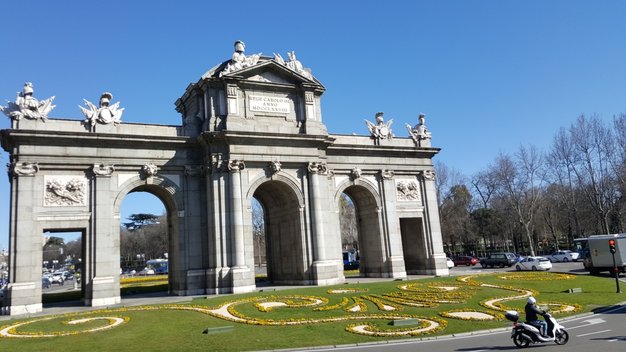
Getting back on the bus, we past a beautiful Alcala Gate. It is a granite monument in the Plaza de la Independencia square. It stands near the city center and several meters away from the main entrance to the Buen Retiro Park. The square is bisected by Alcalá Street.
One curious piece of information about this Gate: It has some statues on top, representing four cardinal virtues: Prudence, Justice, Temperance (or Restraint) and Fortitude (or Courage). In the Alcalá Gate, the cardinal virtues are represented by four children. It is now considered a National Monument.
One curious piece of information about this Gate: It has some statues on top, representing four cardinal virtues: Prudence, Justice, Temperance (or Restraint) and Fortitude (or Courage). In the Alcalá Gate, the cardinal virtues are represented by four children. It is now considered a National Monument.
Almudena Cathedral

Another must see is the Almudena Cathedral. This is a catholic Cathedral. Construction was started in 1883 and completed in 1993. It is modern with chapels and statues of contemporary artists.
Our tour was complete and we decided to go back to the center of the city for our last night in Madrid.
On our walk to the center, we passed a lively bar. We couldn't resist going in. There were locals and tourists enjoying beer, wine and the popular bocadillos (baguette with ham and cheese). It was happy hour and every one was happy. The restaurant had a middle bar where all the action took place. Around the edges were lots of hanging pork shanks. It was amazing the amount of meat that was surrounding me. We had our dinner and walked to the center square. The night life is amazing and you couldn't have had better weather in the beginning of March. On our way back, we walked past the lite Cibeles fountain. What a way to spend our last night in Madrid.
Our tour was complete and we decided to go back to the center of the city for our last night in Madrid.
On our walk to the center, we passed a lively bar. We couldn't resist going in. There were locals and tourists enjoying beer, wine and the popular bocadillos (baguette with ham and cheese). It was happy hour and every one was happy. The restaurant had a middle bar where all the action took place. Around the edges were lots of hanging pork shanks. It was amazing the amount of meat that was surrounding me. We had our dinner and walked to the center square. The night life is amazing and you couldn't have had better weather in the beginning of March. On our way back, we walked past the lite Cibeles fountain. What a way to spend our last night in Madrid.
For help planning your next trip, contact https://www.PetersonTravelPros.com
For more information on sites in Madrid check out 33 things to do in Madrid.
For more information on sites in Madrid check out 33 things to do in Madrid.
